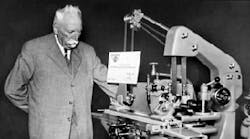In February 1912, with no assured work prospects and no manufacturing program, Fritz Studer (then aged 33) patented his first invention — a noiseless reversing table. World War I brought difficulties for the one-man company, but later he incorporated the enterprise, a move that met with success as the economic conditions improved. Beginning in 1926, Fritz Studer AG began manufacturing critical precision tools for production of watch-stones by the newly established Watch Stones Co., also in Thun, providing complete manufacturing equipment for the operation.
By the beginning of the 1930s, the Fritz Studer AG workforce had increased to 36 employees, and despite the economic crisis, the company was producing 38 machines a year. Included among these were a large series of orders from Russia, where the company first exported one of its machines in 1931. These designs were among the first successes for Alfred Studer, who had joined the company in 1929. In addition to planning expansions, he concentrated on developing a global sales organization. After various building expansion stages in 1944, 1945, and 1956, the factory area had grown to 10,000 square meters in 1962. Since then the company has undertaken regularly expansions in keeping with ongoing developments in production and manufacturing technologies.
Dr. Marc Studer, the third generation of the Studer family, began to establish the brand by exhibiting machines colored Bordeaux red and white. Receiving positive reactions from customers, in 1985 the company settled on this color scheme, establishing an image as well as the standard that Fritz Studer AG machines should be better and more beautiful than the competition.
The range of different machine types expanded too, from conventional cylindrical grinding machines through to CNC cylindrical grinding machines for small- to medium-sized workpieces. Single-purpose machines with optimized grinding cycles were added to the range for large-batch production, as well as a combined machine tool for process optimization and internal cylindrical grinding, with up to four internal grinding spindles.
Since 1994, Fritz Studer AG has been a part of the Körber-Schleifring Group, which includes companies specializing in tool grinding, profile grinding, and cylindrical grinding. It remains a preeminent source of expertise for cylindrical grinding applications, and along with its affiliates, Schaudt and Mirosa, Studer maintains an extensive machine program and service and dealer network for cylindrical grinders.
The continued development of sophisticated technologies requires sharp minds as well as the use of premium products in production. Studer has more than 80 engineers and designers at work developing products and resolving problems in its application center.
Advanced production concepts are also important for Studer, including internal software and hardware development and collaboration with research institutes. Studer's technological expertise is underscored by its Customer Center and Tech Center, which conduct more than 400 grinding trials and tests per year. In the future, Studer indicates its machines will be lighter and more dynamic, and characterized by greater intelligence and economy in energy consumption: it claims its goal now is to reduce CO2 emissions resulting from production and operation of its machines.
Over its first 100 years, Studer has delivered more than 21,000 cylindrical grinding machines worldwide.








